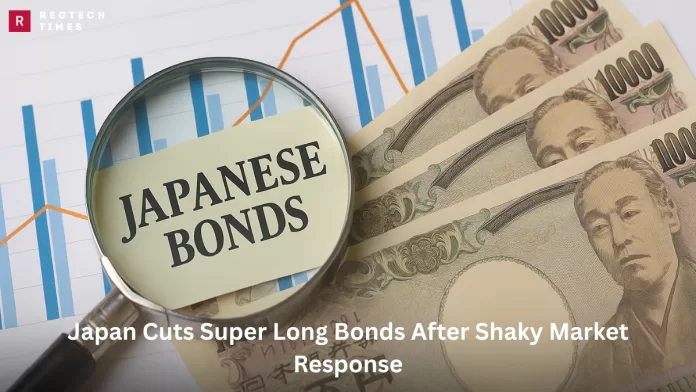Japan’s government is making a rare mid-year change to its bond sales plan by cutting back on the amount of super-long bonds it offers. These are bonds that take 20, 30, or even 40 years to repay. The adjustment comes after recent auctions showed weak demand and long-term bond yields surged to record highs, causing concern in financial markets.
To calm the situation, the Ministry of Finance plans to reduce sales of these long-term bonds by about 10% compared to its original plan. Specifically, sales of 20-year bonds will be reduced by 900 billion yen to 11.1 trillion yen, 30-year bonds by 900 billion yen to 8.7 trillion yen, and 40-year bonds by 500 billion yen to 2.5 trillion yen.
Starting in July, the government will cut 100 billion yen from each auction of these three types of bonds. As a result, the total amount of Japanese government bonds (JGBs) to be issued for the year ending in March 2026 will decrease by 500 billion yen, bringing the revised total to 171.8 trillion yen. That’s approximately $3.44 billion, based on the exchange rate of 145 yen to the U.S. dollar.
A Strategic Move to Calm a Shaky Market
The Ministry’s decision is in response to concerns about oversupply. A sharp rise in super-long bond yields last month, fueled by weak investor demand, unsettled the bond market. This happened just as the Bank of Japan (BOJ) announced plans to slow down its bond-buying taper starting next fiscal year. The central bank’s decision signals a cautious exit from its long-standing, ultra-loose monetary policy.
To better manage the market, the government also plans to buy back some older super-long bonds that carry very low interest rates. This could help balance supply and demand, easing pressure on the bond market.
At the same time, the Ministry of Finance is shifting focus to shorter-term borrowing. Sales of one-year and six-month treasury discount bills, as well as two-year bonds, will each rise by 600 billion yen. Two-year bond sales will increase by 100 billion yen at each auction starting in October, bringing each sale to 2.7 trillion yen.
The government also aims to boost sales of principal-guaranteed JGBs, which are specially designed for households. These will increase by 500 billion yen to encourage broader participation from the public.
Mixed Market Response and Expert Insight
The bond market reacted quickly to the news. In a recent auction, demand for five-year JGBs was the strongest in nearly two years. This enthusiasm helped push the yield on five-year bonds down by 4 basis points to 0.965%, as bond prices rose. However, the 30-year bond yield increased slightly by 1.5 basis points to 2.945%, showing that investors remain cautious about longer-term debt.
German Bonds No Longer Sacred? Japan’s $18B Bond Sell Signals Deep Doubts in Western Economies
Some observers were surprised by what wasn’t changed. Katsutoshi Inadome, a senior strategist at Sumitomo Mitsui Trust Asset Management, noted, “It was a (positive) surprise to the market that the government is not increasing sales of five-year JGBs in the revision.” However, he also warned that relying more heavily on short-term debt could be risky. “Heavier reliance on shorter-term bonds is a sign of Japan’s falling credit quality,” he added, pointing out that managing national debt requires lawmakers to act with a real sense of urgency.
The original bond plan had already included some cuts to 30- and 40-year bonds, anticipating that life insurers would reduce their purchases. These firms had largely completed buying longer-dated bonds to meet new regulatory standards. But as concerns over rising global debt levels grew, super-long JGBs came under heavy selling pressure from international investors last month.
